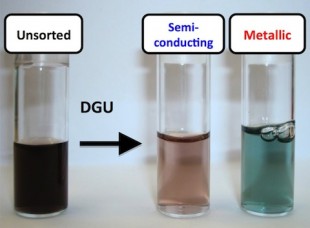Dec 9 2013
Carbon nanotubes carry plasmonic signals in the terahertz range of the electromagnetic spectrum, but only if they’re metallic by nature or doped.
 The ability to sort carbon nanotubes by type through a process called “density gradient ultracentrifugation (DGU)” allowed Rice researchers to test purified batches of nanotubes to find the cause of terahertz peaks in spectroscopic experiments. They determined that free electrons formed plasmons that ripple at terahertz frequencies in metallic and doped nanotubes. Courtesy of the Kono Laboratory
The ability to sort carbon nanotubes by type through a process called “density gradient ultracentrifugation (DGU)” allowed Rice researchers to test purified batches of nanotubes to find the cause of terahertz peaks in spectroscopic experiments. They determined that free electrons formed plasmons that ripple at terahertz frequencies in metallic and doped nanotubes. Courtesy of the Kono Laboratory
In new research, the Rice University laboratory of physicist Junichiro Kono disproved previous theories that dominant terahertz response comes from narrow-gap semiconducting nanotubes.
Knowing that metallic or doped nanotubes respond with plasmonic waves at terahertz frequencies opens up the possibility that the tubes can be used in a wide array of optoelectronic amplifiers, detectors, polarizers and antennas.
The work by Kono and his Rice colleagues appeared online recently in the American Chemical Society journal Nano Letters.
Scientists have long been aware of a terahertz peak in nanotubes, the tiny cylinders of rolled-up carbon that show so much promise for advanced materials. But experiments on batches of nanotubes, which generally grow in a willy-nilly array of types, failed to reveal why it was there.
The origin of the peak was not explainable because researchers were only able to experiment on mixed batches of nanotube types, said Qi Zhang, a graduate student in Kono’s group and lead author of the paper. “All the previous work was done with a mixture of semiconducting and metallic tubes. We are the first to clearly identify the plasmonic nature of this terahertz response,” he said.
Rice’s growing expertise in separating nanotubes by type allowed Kono and his group to test for terahertz peaks in batches of pure metallic nanotubes known as “armchairs” as well as nonmetallic, semiconducting tubes.
“Metallic carbon nanotubes are expected to show plasmon resonance in the terahertz and infrared range, but no group has clearly demonstrated the existence of plasmons in carbon nanotubes,” Zhang said. “Previously, people proposed one possible explanation — that the terahertz peak is due to interband absorption in the small band gaps in semiconducting nanotubes. We rejected that in this paper.”
Plasmons are free electrons on the surface of metals like gold, silver or even aluminum nanoparticles that, when triggered by a laser or other outside energy, ripple like waves in a pond. Strong waves can trigger plasmon responses in adjacent nanoparticles. They are being investigated at Rice and elsewhere for use in sophisticated electronic and medical applications.
The Kono group’s research showed plasmons rippling at terahertz frequencies only along the length of a nanotube, but not across its width. “The only way charge carriers can move around is in the long direction,” Kono said. The researchers previously used this fact to demonstrate that aligned carbon nanotubes act as an excellent terahertz polarizer with performance better than commercial polarizers based on metallic grids.
Nanotubes can be thousands of times longer than they are wide, and the ability to grow them (or cut them) to specific lengths or to dope semiconducting nanotubes to add free carriers would make the tubes highly tunable for terahertz frequencies, Kono said.
“This paper only clarifies the origin of this effect,” he said. “Now that we understand it, there’s so much to do. We will be making various terahertz devices, architectures and systems based on carbon nanotube plasmons.”
Rice alumni Erik Hároz, now a postdoctoral researcher at Los Alamos National Laboratory, and Lei Ren, a researcher at TGS, co-authored the paper with undergraduate student Zehua Jin, postdoctoral researcher Xuan Wang, senior research scientist Rolf Arvidson and Andreas Lüttge, a research professor of Earth science and chemistry, all of Rice. Kono is a professor of electrical and computer engineering and of physics and astronomy and of materials science and nanoengineering.
The Department of Energy, the National Science Foundation and the Robert A. Welch Foundation supported the research.